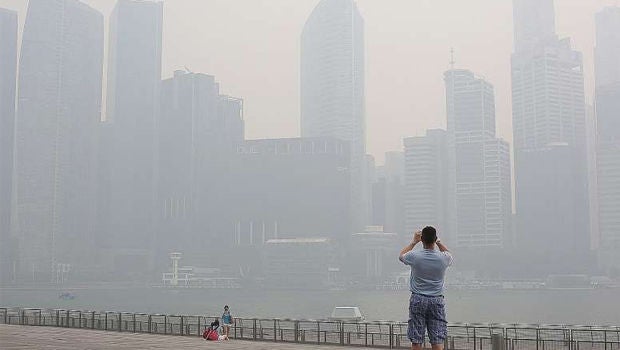
Haze shrouding the Singapore city skyline in June 2013. The results of the study give more urgency to solve the issue of transboundary haze, and the need to protect more vulnerable populations like the elderly at such times. ST FILE PHOTO
By: Abigail Ng WY, The Straits Times
First local study to link haze with mortality; men above 65 found most vulnerable
When haze blows into the country, a strong burning smell is not the only thing Singaporeans should be concerned about.
Poorer air quality is also linked to an increased risk of cardiac arrests occurring outside of hospitals, according to a nationwide study led by the Singapore General Hospital (SGH).
Comparing data for all reported cases of out-of-hospital cardiac arrests (OHCA) between 2010 and 2015 with air quality, researchers found that the short- to intermediate-term risk of OHCA increased by up to 30 per cent when the Pollutant Standards Index (PSI) level entered the unhealthy range of above 100. There were more than 8,500 such cardiac arrests in the period studied.
The most vulnerable were men above the age of 65. The mean age of those who suffered a cardiac arrest was 66, with 65 per cent being men.
The study also found that every 30-point increase in PSI levels was associated with an additional risk of 5 per cent to 19 per cent, on top of risks associated with other factors such as age and physical health.
The first local study to show the impact of transboundary haze on mortality will be presented at the SGH Annual Scientific Meeting on Friday.
Associate Professor Marcus Ong, senior author of the study and senior consultant at SGH's department of emergency medicine, said that the direct relationship between haze and mortality lent urgency to solving the issue of transboundary haze.
Cardiac arrest is a sudden heart malfunction in which the heart stops beating. In Singapore, OHCA survival rate is around 15 per cent, said Prof Ong. Though the study did not research causes, the heightened risk may be due to the body needing to work harder to breathe normally, among other factors, he said.
The study also found that the elevated risk was not limited to the day of exposure, but lingered for up to five days after a spike in PSI levels.
The dry season from June to October often brings haze to the region because of fires that are started to clear land.
The study increases awareness of the health impact of haze on a population, said Prof Ong. "We need to consider how we can protect more vulnerable populations like the elderly. Some things to consider would be when to stay indoors versus allowing normal activities."
The National Environment Agency recommends that healthy people reduce prolonged or strenuous outdoor physical exertion when the PSI level creeps into the unhealthy range, and that elderly people, pregnant women and children minimise such activities.
Dr Edgar Tay, senior consultant at the National University Heart Centre Singapore's department of cardiology, said the results are consistent with previous studies linking air pollutants with OHCA.
He added: "It would be of interest in future to determine how different pollutants exact their effects."
Researchers from the Singapore Health Services, Monash University (Australia), the Singapore Civil Defence Force and Duke-NUS Medical School also took part in the study.
SOURCE: THE STRAITS TIMES. SINGAPORE PRESS HOLDINGS LIMITED. REPRODUCED WITH PERMISSION.
Contributed by














 Get it on Google Play
Get it on Google Play